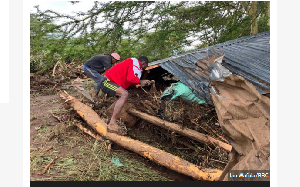Health News of Friday, 16 January 2015
Source: GNA
Stakeholders attend Nutrition Review and Planning Meeting

Stakeholders in the health sector have attended this year’s Nutrition Review and Planning Meeting in Wa in the Upper West Region.
The two-day meeting was on the theme: “Harnessing Sectors for Multi-sectoral Coordinating and Planning for Nutrition”.
Participants reviewed nutrition-specific and nutrition-sensitive activities in the region and came out with plans for scaling up priority interventions in 2015 to meet the specific objectives of the national nutrition policy as part of the common results framework of Ghana.
According to the Upper West Regional Director of Health Services, Dr Abdulai Adams Forgor, acute malnutrition, which could be prevented and managed with optimum nutrition and improved health, had increased from 7.7 per cent in 2006 to 9.2 per cent in 2011.
Quoting from the World Food Programme Comprehensive Food Security and Vulnerability Analysis Report of 2012, Dr Forgor said 22.3 per cent of households in the region were moderately food-insecure and 1.4 per cent were severely food-insecure.
This, he said, meant that a total of 23.7 per cent of households suffered from one level of food insecurity or an other, while from 2006 to 2011, households that used improved sanitary facilities had increased from 17.3 per cent to 24.3 per cent and with open defecation by adults decreasing from 78.7 per cent to 71.1 per cent.
“This is still very serious and has a lot of health implications and increased infection rates which eventually result in under-nutrition in children less than five years,” he said.
Dr Forgor added that it was not surprising that the region was not doing well in terms of increased rates of under-nutrition and sanitation, because it was still bedeviled with food insecurity, poor hygiene and sanitation practices.
He said immediate determinants of this under-nutrition were inadequate food intake and disease or infections among children less than five years in the region.
Dr Forgor, who also gave perturbing statistics on stunting among children, said stunting for the region was 22.5 per cent in 2006 but had increased to 23.1 per cent in 2011.
Stunting is chronic under-nutrition which can start in utero, when a pregnant woman is malnourished during her pregnancy.
The regional director of health services said stunting had serious impact on the life of a growing child, both short term and long term, with the short term implications being its ability to affect cognitive, motor and language development of the affected child.
Some of its long-term challenges include increased health expenditure and opportunity costs for care of the sick and increased morbidity and mortality, as well as reduced learning capacity, poor school performance and work capacity and productivity, among others.
Dr Forgor said the Regional Health Directorate was implementing several nutrition interventions to help prevent malnutrition or manage it.
He mentioned the Infant and Young Child Feeding Practices (IYCF) as one of the preventive interventions which involved counselling of caregivers and other family members on infant and young child feeding practices at the various health facilities and at the community level.
The IYCF targeted pregnant women and women with children less than five years to help improve maternal and child care practices at the household level.
Dr Forgor said the Community-Based Management of Severe Acute Malnutrition was also a rehabilitative intervention for children with severe acute malnutrition or severe wasting, who were sent to the facilities and rehabilitated using therapeutic food.
Children less than five years with this condition were treated at the out-patient department and those with severe conditions were admitted.
He said People Living with HIV and AIDS and Tuberculosis were also treated with fortified blended flour in addition to the plumpy nuts from World Food Programme under the Nutrition Assessment, Counselling and Support intervention.
The regional directorate has also embarked on a campaign aimed at informing people about the importance of consuming iodised salt at the household level meant to achieve 90 per cent adequate salt iodisation at the household level.










